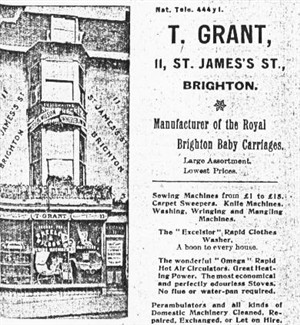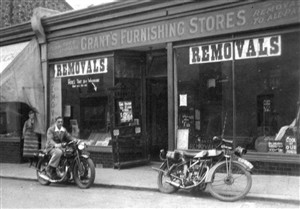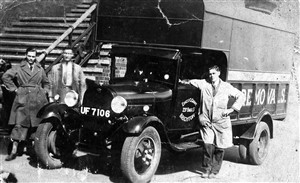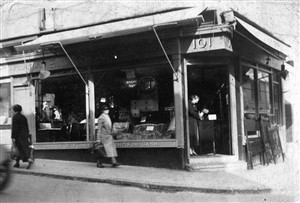Brighton Shops in the Bloodline
Hays & Grants
By Roy Grant

Thomas Grant 11 St James Street in 1910
Pikes 1910 Street Directory

Hay's Shop far right in 1922
R Jeeves, Queens Road

Hay's Shop before demolition c1932
Rolls & Beevers collection

Grant shop in Baker Street c 1932
Family Photo (notice Brough Superior bike)

Dad (far left) and his first removals truck
Family Photo

Grant shop 101 Gloucester Road c1938
Family Photo
The first 'Brighton shopkeeper' in my family was my paternal G. Grandfather, Thomas Petty Grant from Winterbourne Stoke in Wiltshire. Early records have him as Thomas Grant Petty, mainly because he was born well before his parent's marriage.
His first venture into shopkeeping was in 1886 when he opened a domestic appliance and sewing machine shop at 23 George Street. I initially thought it to be the George Street off St James' Street, but found it to be 'West Brighton' and therefore in Hove. Although I have no pictures of that shop from the past, externally it appears to have seen little change since it was first built.
Thomas' first wife died in December 1887, and having himself and a reasonable number of young children to care for, he found it convenient to take another, which he did.
Soon after this, he moved to 11 St James Street, adding perambulators, domestic appliance hire, home made polishes and a domestic staff employment agency to his range of services. A lot of his business came from retired gout ridden colonels and the like, who came to Brighton for the air. They hired wicker bath chairs from him, and had their pretty young nurses parade them up and down the promenade. Each chair was secretly branded and porters at Brighton station were paid a shilling if they aprehended anyone trying to load one of his chairs back onto the London train.
A block away was my maternal grandfather, Francis Clifton Hay. Francis and his elder brother John had both started out making shoes with their father John Erskine Hay in various basement propetities throught the town where they lived as well as worked. It was one of my grandmother's proudest boasts that the first thing she ever sold as Francis' 16 year old bride, was a farthing's worth of boot laces.
Both Hay brothers prospered with the family on John's side going into the electrical and radio trade having shops in Hove, Trafalgar Street, Sydney Street, and elsewhere. Due to inter family rivalry and confusion over the mutual use of the name 'Hay & Sons' (specifically in the electrical trade) they also had disclaiming ads printed on the buses saying one company was in no way connected with the other. A sideline of these Hays was Politics, for one became the mayor of Brighton in 1953 and another the Tory MP for Hendon, who had the unfortunate distinction of introducing parking meters into the UK.
By 1901, my grandfather Francis Hay had upgraded from shoes, to oil lamps and china in a shop at 9 Surrey Street, but then began opening secondhand furniture shops in Grand Parade, Gloucester Place and at 16 Edward Street. Family members were living over the Edward Street shop until the mid 1930s when Francis died and the shop was compulsory purchased. It was levelled under a so called slum clearance and local redevelopment scheme but work failed to start and for many years it was a vacant lot used as a temporary coach and car park.
Some 50 years later when that 'oh so essential' 1930s rebuilding programme finally started and the foundations for American Express were dug, they unearthed the shop's former cellar containing lots of WW1 artifacts. My parents explained, this was not a secret cashe for terrrorists, it was just one of the numerous lots Francis had bought at auction and had been unable to sell on.
My grand mother, Emily Hay gave all her children the opportunity to go into the retail trade. Son Frank had various electrical shops and ended up with 'an Aladdin's Cave' at Seven Dials. Son John became an antique dealer with a shop in Buckingham Road, Son Arthur had a cafe in Viaduct Road, and two of her daughters, Rose and Violet had a sweet shop also in Edward Street. The latter was a dismal failure for R & V increased their waistlines and gave much of the stock away to their many friends.
My grandmother continued in the furniture trade until she was almost 80 moving into the sweet shop she had ousted her daughters from in the late 1930s and by the end of WW2, was back in Surrey Street. I have no idea what she would make of the 'marital' artifacts they sell in that particular shop now, but that was where I was deposited in a pram during the war, spent my early years after school and my summer holidays.
When my father married Emily, Gran's eldest daughter in 1928, they too went into the second hand furniture trade, having a shop at 15 Edward Street (corner of William Street) then Baker Street and finally Gloucester Road. Above are pictures of two of these and my father's delivery truck which he proudly boasted was the first Luton Van in Brighton. For him this was a major acquistion, for until then he was doing all his furniture deliveries throughout Brighton & Hove on a costermonger's barrow.
Unfortunately the depression followed by WW2 ended my father's attempt to become a successful local trader, but I imagine from the number of auction rooms I was taken to as a child and an inheriance of my uncle John's tactile love of antiques, I too had the opportunity to become another Brighton Shopkeeper.
This page was added on 06/03/2009.